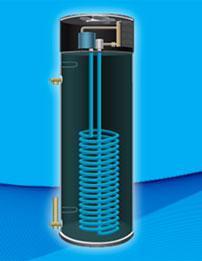Domestic water heating costs the average household up to $700 per year. What if you could slash that cost by 60%? Compared to a standard electric storage water heater, a heat pump water heater uses 2-3 times less energy, saving thousands in utility costs over the life of the water heater.
How does it work?
Heat pump water heaters (HPWH) work by transferring heat rather than creating it. A fan on top of the HPWH pushes room air across a radiator grid filled with cold liquid refrigerant that has a low boiling point. The air’s heat raises the refrigerant  temperature enough to turn it to a gas, after which a compressor increases the pressure of the gas, further raising its temperature.
temperature enough to turn it to a gas, after which a compressor increases the pressure of the gas, further raising its temperature.
A pump circulates the hot compressed gas down and around the cool water in the heater’s tank, heating the water and cooling the gas back to a liquid. The liquid is pumped back to the radiator, and the cycle starts again. In a nutshell, conventional water heaters make heat, but an HPWH moves it from one place to another instead of generating it directly, resulting in less energy use and cost savings — it’s like a refrigerator in reverse
All HPWHs, sometimes known as hybrid water heaters, also contain electric heating elements in the tank that provide back-up heating during times of very heavy usage.
Selecting a heat pump water heater
The purchase price of a HPWH is higher than a regular electric unit, about $1200 compared to $500. Both generally come with 10 year warranties and LED displays that allow for choosing different operating modes including “vacation.” The difference of course lies in their efficiency. According to Consumer Affairs, a family of four will spend $330 less on hot water every year by switching to an HPWH from a conventional electric unit. With these savings, you will make up the difference in price in 18 months and save so much more year after year.
Whatever type of water heater you choose, shop ENERGY STAR® certified products for high efficiency models and be sure to search for any available rebates. Go to www.dsireusa.org for a searchable database of state incentives. Visit www.energystar.gov/rebatefinder to find utility rebates, or check with your utility provider. Your particular locality may also offer incentives for HPWHs or other energy efficiency upgrades.
Installation
Standard electric water heaters are often tucked in small closets but HPWHs need more space to have enough warm air to power the heat pump. Most manufacturer recommendations say at least 100 square feet. And remember, an HPWH removes heat and lowers the temperature of the room where it’s located, so placing it in a room you already pay to heat is counterproductive. A utility room or basement with a furnace or clothes dryer is the ideal location for these reasons, and also because HPWHs can be as noisy as a window air conditioner.
Request estimates in writing, check references and check the company with your local Better Business Bureau when selecting a qualified installation professional. If you’re an intrepid DIYer, check out this step-by-step video by This Old House.
The savings
The math is clear, heat pump water heaters will save you a lot of money – up to $3,500 in the decade your heater is under warranty. Just as compelling are the substantial environmental benefits. ENERGY STAR® calculates that if every residential electric water heater in the country were replaced with a heat-pump water heater, we would save $11.8 billion each year and prevent 140 billion pounds of annual greenhouse gas emissions, equivalent to the emissions from more than 13 million vehicles.
